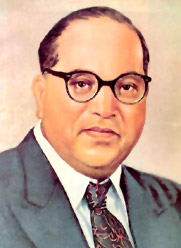 Poona Pact of 1932 is an agreement between the untouchables or depressed classes of India and the Hindus. Dr. B.R.Ambedkar led the depressed class. The Poona Pact took place at Yerawada Jail in Pune, Maharashtra on 24th September, 1932.
Poona Pact of 1932 is an agreement between the untouchables or depressed classes of India and the Hindus. Dr. B.R.Ambedkar led the depressed class. The Poona Pact took place at Yerawada Jail in Pune, Maharashtra on 24th September, 1932.
During the first Round Table Conference, Ambedkar favored the move of the British Government to provide separate electorate for the oppressed classes as was done in case of other minorities like Muslims, Sikh etc. The British invited various Indian leaders in Round Table Conferences during 1930-32 to draft a new constitution involving self rule for native Indians. Mahatma Gandhi did not attend the first Round Table but was present in the later ones. Gandhiji strongly opposed the proposal of separate electorate for the depressed classes as he thought that it would disintegrate Hindu society. He went for an indefinite hunger strike starting from September 20,1932 against the decision of the then British Prime Minister J.Ramsay Mac Donald. Mr. Ramsay granted communal award to the depressed classes as he gave them separate position in the constitution for governance of British India.
The whole country was agitated at the health concern of Mahatma Gandhi. A mass upsurge generated in India to save the life of Gandhiji. Ambedkar was put in a great pressure and he was forced to soften his stand. The compromise between the leaders of caste Hindu and the depressed classes was achieved when Dr. B.R.Ambedkar signed the Poona Pact on September 24, 1932. The resolution was announced in a public meeting on September 25 in Bombay, which confirmed-" henceforth, amongst Hindus no one shall be regarded as an untouchable by reason of his birth and they will have the same rights in all the social institutions as the other Hindus have". This was a landmark step for Dalit movement in India that gave share to the Dalits in the political empowerment of democratic India.
The following text represents the agreement achieved between the leaders acting on behalf of the oppressed classes and of rest of the community, regarding the position of that particular class in the legislature and certain other matters involved with their welfare.
1. There shall be reserved seats for the depressed classes out of general electorate seats in the provincial legislature as follows- Madras 30; Bombay with Sind 25; Punjab 8; Bihar and Orissa 18; Central Provinces 20; Assam 7; Bengal 30; United Provinces 20. Total 148. These figures are based on the Prime Minister`s (British) decision.
2. Election to these seats shall be by joint electorate subjects by the following procedures - the members of the depressed classes formed the Electoral College, which was in liberty to elect the panel of the depressed classes. Voting system was taken into consideration then. The legislature pointed out that the method of the single vote and four persons getting the highest number of votes in such primary elections shall be the candidates for election by the general electorate.
3. The symbol of the Depressed Classes in the Central Legislature shall be based on the principle of joint electorates and reserved seats by the method of primary election in the manner provided for in clause above for their representation in the provincial legislatures.
Central Legislature:
4) In the Central Legislature eighteen per cent of the seats allotted to the general electorate for British India in the said legislature shall be reserved for the Depressed Classes.
5) The system of primary election to a panel of candidates for election to the Central and Provincial Legislatures as herein-before mentioned shall come to an end after the first ten years, unless terminated sooner by mutual agreement under the provision of clause 6 below.
6) The system of representation of Depressed Classes by reserved seats in the Provincial and Central Legislatures as provided for in clauses (1) and (4) shall continue until determined otherwise by mutual agreement between the communities concerned in this settlement.
7) The Franchise for the Central and Provincial Legislatures of the Depressed Classes shall be as indicated, in the Lothian Committee Report.
8) There shall be no disabilities attached to any one on the ground of his being a member of the Depressed Classes in regard to any election to local bodies or appointment to the public services. Every endeavour shall be made to secure a fair representation of the Depressed Classes in these respects, subject to such educational qualifications as may be laid down for appointment to the Public Services.
9) In every province out of the educational grant an adequate sum shall be ear-marked for providing educational facilities to the members of Depressed Classes.



















